Judit Bokor
(University of West Hungary, Szombathely) [Bio]
Email: bokorju@mnsk.nyme.hu
Introduction
The economic environment of a society defines the formation of demographic tendencies and also affects basically the free time facilities of the society.
By the beginning of year 2000 it already became clear that the population of developed societies is aging, while the number of birth in underdeveloped regions is increasing considerably. As a result of the restructuring based on the age, a number of new phenomena are emerging in the mobility of the population, thus in ’experience-driven migration’, that is in tourism as well (Juray, 2004). The number of participants in tourism and their activities pursued at the destinations are relevant indices of the way of living and cultural habits of those living in a society.
During the course of life people belong to several age groups, and these phases of life affect considerably the individual’s mobility, motivation, readiness for travel, and financial situation. Therefore, tourism market is segmented as well, providing a separate tourist market for nearly each age group.
Background
Examination of sporting travel habits is yet a less surveyed area among the researchers of tourism. The present study focuses on their sports activities in thermal spas.
Hungary is among the leaders in health tourism in Europe, as the country possesses the most thermal water following Island, France and Italy. 80% of the country can boast with thermal water beneath, and a great number of medicinal hotels and thermal spas make use of this opportunity. The geothermic gradient in Hungary is 5Cdegree/ 20m, which is outstanding even in global terms.
Objective of the research
In our research work we were investigating, wether health tourists are interested in sporting activities while they are staying in Spa Bük. Our research aims at surveying the needs of the guests of the Medicinal Spa of Bük in relation to sports tourism services. We wished to investigate the present supply involving its quality, quantity, exploitation, and satisfaction level, as well as what kinds of sports tourism products are sought after by the guests of the spa. Present paper shows out, how health tourists are involved, interested in physical activities in the visited spa. I wanted to show out the differences in sporting habits between the different nations tourists, if there are any.
When setting our objective, we were driven by the present situation of the considerable ignorance of a healthy way of living in Hungary, while in a society suffering from a bad state of health we can trace the willingness to do something for our health, in the form of prevention, relaxation or at least rehabilitation. That is why we have chosen a medicinal spa as the site of our research, as the guests visiting the spa already possess a health-conscious attitude. We have defined our objective and our hypotheses being aware of the fact that the spa guests belong primarily to the target group of health tourism. As sport is also an appropriate means of preserving, achieving and getting back into a healthy state, the assumption was evident that the guests could look for sports activities within the framework of the spat. We were interested to know whether the spa guests participating in health tourism consider sports a condition of their health, to what extent, and which forms of sports they seek or would seek in the surveyed spa. Do health tourism and sports tourism exclude or reinforce each other?
Hypotheses
A great majority of the surveyed visit the spa for medical treatment.
Participation in free physical activities is higher among the Hungarian guests compared to foreigners.
Participation in fee-paying sports programs is low among the Hungarian, compared to foreigners.
Methodology:
In order to answer the above questions we have chosen the questionnaire as our primary research method of data collection. Nearly 200 Hungarian and 100-100 Czech and German-speaking guests were surveyed respectively. The location was the second biggest medicinal spa in Hungary, namely the Medicinal Spa of Bük.
Bükfürdő (Bük Spa) can be found in the neighbourhood of Bük settlement in Western Hungary. Its thermal water is recommended primarily in case of locomotor disorders, joint and rheumatic problems. It is contra-indicated in case of cardiac and circulatory diseases, and high blood pressure. The survey by the questionnaires (filled in both by the surveyed personally and with the help of survey conductors) was conducted during the winter period (between November 2008 and March 2009). Significant difference can be traced in the composition of the guests, as two-thirds arrive from foreign countries, and a vast majority of the aforesaid come form German-speaking areas. As a positive tendency, the number of guest arriving from the Czech Republic is increasing progressively, which should be taken into consideration when establishing the various supplies.
Data were analysed by SPSS for Windows 17.0 statistical method, as well as with the help of Excel figures and tables.
Findings
When interpreting the findings we must keep in mind the fact that the guests of the surveyed medicinal spa were participants primarily in health tourism, thus this time they represented primarily the market segment of health tourism.
I would like to show out the differences in sporting habits between the different nations.
In case we wish to examine the sports motivation of those participating in health tourism, we need to find out ‘how’ the surveyed guest has arrived at the spa.
Concerning the entire sample, 51,3% of the Hungarians arrived with social security referral, 9,3% with tourism cheque, and 39,4% were self-financing, while the tourist from abroad were self financed. The above proportions suggest the activities of the surveyed Hungarian guests during their stay, as it is less probable that the large number of guests arriving with social security referrals would seek sports facilities in the spa (Figure 1).
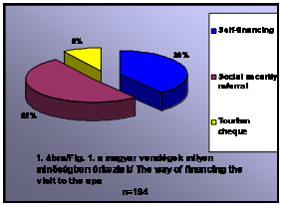
Fig. 1: The way of financing the visit to the spa
The Hungarian has more illness to treat in Spa compared to the foreigners (Fig.2).
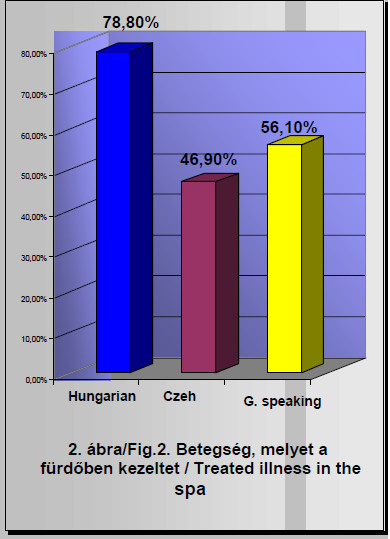
Fig. 2. Treated illnesses in the spa
Thus, that Hungarian come mainly to recover, while the other nations for relaxing (Fig.3).
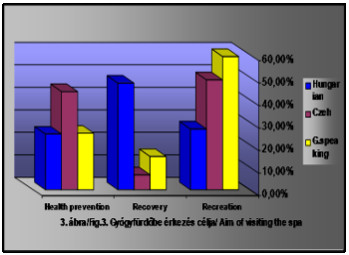
Fig. 3. Aim of visiting the spa
Based on their own judgement, 72,% of the surveyed tourists were aware of the health preserving effects of sports activities. Most of them considered sports activities beneficial in preventing cardiac and circulatory diseases (44,2%), but a high percentage of them (40,4%) considered them useful in case of joint problems as well.
Positive effects of sports activities were similarly considered important against overweight, for general muscle strengthening (improving posture) and in regulating blood pressure (36,5%). In case of osteoporosis only 17,3% considered them useful.
Even though they were quite aware of the beneficial effects of sports activities, only
57% of them participated in the free sports activities of the spa, and only 45,5% pursue sports regularly at their permanent residence. (The spa offers only one free sports activity, namely water gymnastics. This is not enough).
55,2% of those taking part in this free activity in the spa said that they participated for the joy of doing physical exercise, while 31% were looking forward to the well-being following exercise. 21,8% participated in order to recover, while 20,7% to relax. If so, how was the practice, the participation in sport activities?
Free sport activities for health preservation were the most popular among the Hungarian guests (Figure 4.), while their number was the smallest in relation to participation in fee-paying sport programs (Fig.5). The spa unfortunately is unable to meet such demand, as they provide only one free program, as opposed to the nine fee-paying ones.
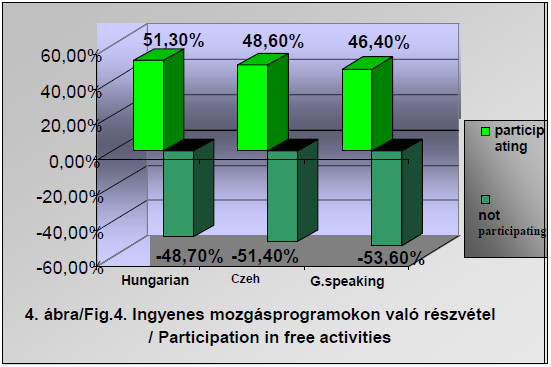
Figure 4. Participation rate in the fee-paying sports programs
While in the free activities the Hungarians were the most active with 51,3%, in fee-paid activities (Fig.5) they were the last to participate (29,41%)
Figure 5: Participation in the fee-paid sport programs
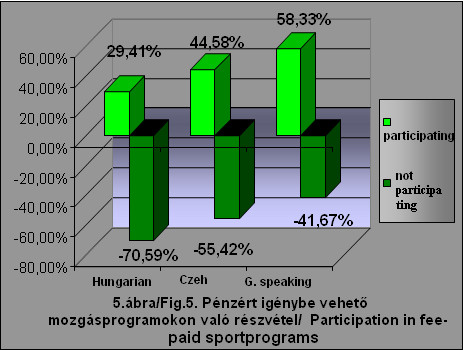
The spa offers the following fee-paying sports programs for their guests: Aqua Bike, Spine gymnastics, Swimming courses, Aqua Step, Biking tours, Autogenic training, Aqua Relax, Nordic Walking, Fit Ball, Aerobics, Tai Chi. The process of the programs range between HUF 300-1000. Among the small number of participants of fee-paying programs Aqua Bike (48,3%) and Aqua Relax (21,1%) were the most popular. Nordic Walking and Aqua Step were also popular (8,8%) among the few participants. Among those not participating, 30% explained it by their financial situation, while 20% said that they were interested only in the thermal water, that is why they did not do sports.
Among those participating either in free or in fee-paying sports programs, they were attracted by the well-being caused by sports (55%), while 54,4% were motivated by health preservation. Further motivational reasons for doing sports activities: lack of exercise: 31,3%, curiosity: 15%, reasonable price: 12,8%, good company: 6,3%, advertising: 7,6%, and finally boredom.
Where should we find the reason, not to pay for the sport programs? One reason can be financial one (Fig.6).
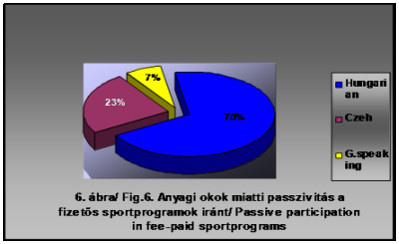
Fig.6: Passive participation in fee-paid sportprograms
In case of those who did not take part in any sports programs, 18% identified laziness. Other reason should be the lifestyle, the way they live at home. Fig. 7 shows the participation in sport or in some kind of phisycal excercises at permanent places. Sorry to see, that the Hungarian are less interested in phisycal activities, compared to the foreigners.
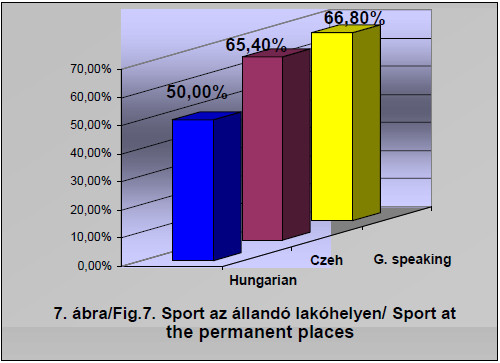
Fig. 7 Sport at permanent places
We are also less active in frequency of doing exercises compared to the Czech and German speaking tourists (Fig.8).
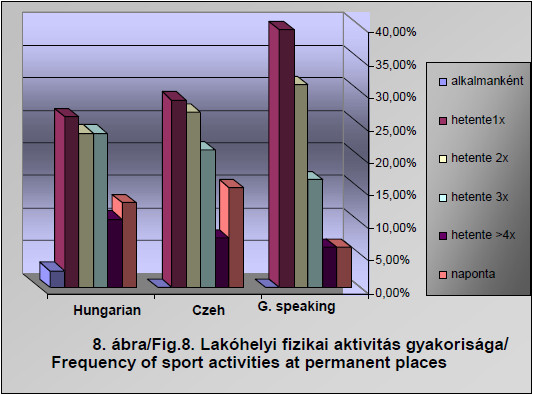
Fig.8: frequency of sport activities at permanent places
The quests’ financial background was rated on a scale of 5. The average was in the middle, but the people from abroad had better financial background.

Fig.9: Financial situation of the spa guests (weakest, weak, mediocre, better, good).
Summary
My first hypothesis that the majority of the surveyed visit the spa because of recovery/treatment has proved to be true only in case of the Hungarian guests. The other two proved to be true, that Hungarian take part mostly in free-paid and not in fee-paid activities.
The findings of my research reveal that the guests visiting the Medicinal Spa of Bük do not really pursue sports activities during their stay in the spa. However, it seems to contradict the fact that a high proportion of them do sports activities at their permanent residence. This is comprehensible, as the survey was conducted at a location which serves health promotion.
The reason for the passive attitude towards sports of the guests pursuing sports activities at their permanent residence can be manifold.
For many guests sports are excluded by the main motivation of having a rest.
The supply of sports activities is not varied. The only physical activity provided free, namely water gymnastics was popular among both age groups. In case of fee-paying programs the reason for not participating is of financial matter among Hungarian guests, the participation rate of the foreign guests is higher.
Finally, it can be stated that my hypothesis concerning the guests of the spa seeking active sports facilities in large numbers has not turned out to be true. In my opinion the reason for this, besides the low number of facilities provided, is that this market segment of health tourism is yet not mobile enough towards activities not strictly related to spa-specific activities.
Literature
Becsei, J. (2004): A népesség struktúrája. Népességföldrajz. 205-282.
Magyar Turizmus Rt. (2004): A senior korosztály utazási szokásai. MÁST Piac- és Közvéleménykutató Kft.
Juray, T. (2004): A demográfiai változások hatásai a turizmus folyamataira napjainkban.
Magyar Földrajzi Konferencia (cd-rom).
